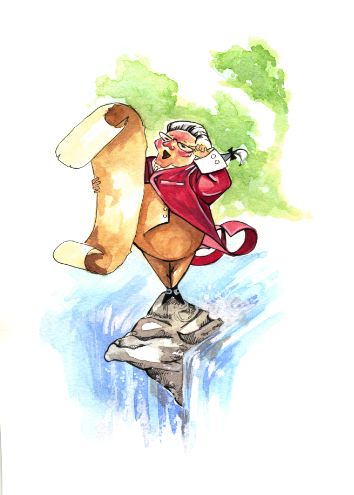
HONEYMOON COUPLETS
By Andrew Porteus
Although Europeans did not visit Niagara Falls until 1678, the first
printed reference to the great cataract was made in a book written by
Samuel de Champlain in 1604. Included in this book, just after the
dedication, is a sonnet in which an allusion is made to Niagara Falls.
Ever since then, the Falls has inspired verse from poets and non-poets
alike.
The reputations of at least two poets were solidified by poems written about the Falls. John Brainard’s 1826 poem “The Falls of Niagara” was written in 15 minutes when Brainard, editor of the Connecticut Mirror, needed some extra material to fill out a page. Brainard had never seen the Falls, but was inspired by a picture on his wall. This 19-line poem brought him instant fame and the pronouncement in 1874 that this was the best poem ever written about the Falls.
Supporters of Cuban exile José María Heredia disagree. Heredia’s poem “Niágara,” written in 1824 and translated into English by William Cullen Bryant in 1827, remains one of the most outstanding poems about Niagara ever written. Heredia rewrote “Niágara” in 1832, sparking a debate still not resolved over the ‘definitive’ and ‘most literary’ version. It must be noted, however, that this raging debate is not usually found in the watering holes and meeting places of Niagara, but only in the rarified circles of cognoscenti who have actually heard of these people, and have managed to track down and read their poems of Niagara.
Over the course of years many hundreds of poems have been written about the Falls. They range from book-length poems such as Reverend J.L. Alexander’s melodramatic “Wonders of the West,” or, “A Day at the Falls of Niagara” in 1825 and Joan Murray’s “Queen of the Mist,” to the single-stanza poems recorded for posterity in The Table Rock Album. (Incidentally, Alexander’s book lays claim to be the first book-length poem to be published in Upper Canada. It was also published under the pseudonym ‘A Canadian’ since it was not seemly for a man of the cloth to be writing such frivolous material.) In 1921, Charles Dow compiled his Anthology and Bibliography of Niagara Falls. The music, poetry, and fiction section of this tremendous undertaking alone took up 153 pages. There have been many anthologies of poems published, including Myron T. Pritchard’s Poetry of Niagara of 1901, part of Volume 27 of Henry Longfellow’s Poems of Places, and part of Kevin McCabe’s 1999 anthology The Poetry of Old Niagara.
The subject matter of these poems falls fairly neatly into two categories: those inspired by the geographical or geological wonders of the Falls, and those inspired by the events that have taken place there. Some of the most poignant poems fall into the latter category.
William Dean Howell’s “Avery,” about efforts to rescue a man clinging to a rock at the brink of the Falls, and Duncan Campbell Scott’s “The Battle of Lundy’s Lane,” written as a recollection of a volunteer who fought beside his soon-to-be-killed son, come to mind. The debate over who won the war of 1812 is reflected in poetry of each side. Charles Jones’s “The Hero of Bridgewater” recounts the triumph of Scott’s American forces over the Canadian alliance, while William Kirby’s “Sonnet Read at the Unveiling of the Lundy’s Lane Monument, 25th July, 1895” recounts the victory of Drummond’s forces over the Americans.
The geological/geographically inspired poems about Niagara are plentiful. Caroline Eleanor Wilkinson, Lydia Sigourney, and Louis Honoré Frechette all wrote about the awe-inspiring and beauteous Niagara. These earlier poets write of the “dread abyss,” the “majestic power,” and the “wild torrent” of Niagara. The sense of cruel nature at its most horrific but at the same time most splendorous is very real in these poems, and is very much lacking in the later ones. One hesitates to speculate, but perhaps the advent of easy travel to other wondrous places, making sights such as the Falls commonplace through television and motion pictures, and the diversion of great amounts of water to hydro canals all have conspired to lessen the impact of the Falls.
Tracking down the poetry of Niagara is not easy. Dow’s Anthology is a wonderful resource, but it was published 80 years ago and did not include many poems that already existed. Poems of Niagara have been found in obscure journals, school textbooks, newspapers and magazines, and even in the proceedings of an electrical conference. Serendipity plays a large role. Many of the poems collected on the Niagara Falls Poetry Project Web site were found while researching questions in the Niagara Falls Public Library Local History Department that had nothing to do with poetry. After a few years of keeping track of these poems, it was decided to launch a Web site to ensure that they would not be lost and could be shared with others. Since the site was launched in spring of 2000 many more poems have been submitted by people viewing the site. J.A. Murphy’s marvelous “Ode to a Bytown Youth” was submitted by an ancestor of the hero of the poem, which had been published in the Ottawa Citizen in 1938. This footnote to history in poetic form would likely have been lost without this site.
Illustration by Margaret Amy Reiach